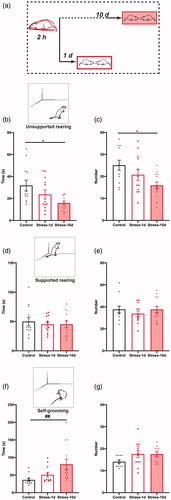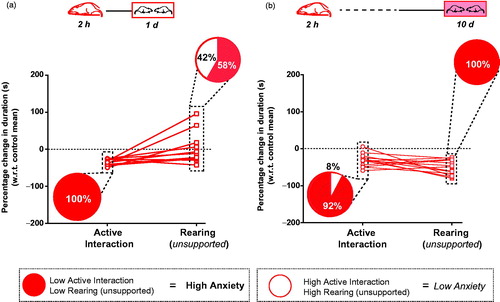Figures & data
Table 1. Details of statistical analyses for all behavioral parameters analyzed.
Figure 1. Stress causes a decrease in social interaction 1 day later that persists up to 10 days later. (a) Animals were subjected to 2-hours of immobilization stress, and social interaction was measured either 1 day or 10 days later, in separate groups of animals. (b) Stress reduces the number of nose-to-nose contacts (inset) 10 days later. (c) Stress leads to a significant reduction in time spent in active interactions (inset). (d) Stress also reduces number of interactions, both 1 day (Stress-1d) and 10 days (Stress-10d) later. (e) Time spent in active following (inset), or (f) number of active follows does not change either 1 day or 10 days after stress. (g) Total time spent in anogenital sniffing (inset) decreases significantly both 1 and 10 days after stress. (h) Total number of anogenital sniffs also decreases significantly both 1 day and 10 days later. (i) Time spent in and (j) number of crawling under (inset) episodes does not change at 1 or 10 days after stress. (k) Time spent is allogrooming (inset), and (l) number of allogrooming bouts also does not change 1 or 10 days after stress. (Control, N = 12 pairs, Stress-1d, N = 12 pairs, Stress-10d, N = 13 pairs). * indicates p < .05, ** indicates p < .01, *** indicates p < .001, **** indicates p < .0001 in post-hoc Tukey’s test.

Figure 2. Stress leads to only delayed changes in asocial anxiety-like behavior. (a) Animals were subjected to 2-hours of immobilization stress, and social interaction was measured either 1 day or 10 days later, in separate groups of animals. (b) Total time spent in unsupported rearing (inset) decreases significantly 10 days but not 1 day after stress. (c) Total number of unsupported rears decreases significantly 10 days after stress. (d) Total time spent in supported rearing (inset) and (e) number of supported rears remain unaffected by stress. (f) Total time spent in self-grooming (inset) shows a significant increase only 10 days after stress, but not 1 day later. (g) Number of self-grooming bouts remain unchanged. (Control, N = 12 pairs, Stress-1d, N = 12 pairs, Stress-10d, N = 13 pairs). * indicates p < .05 post-hoc Tukey’s test. ## indicates p < .01 in post-hoc Dunn’s test.

Figure 3. Divergent patterns of social and asocial anxiety within the same animal after stress. Proportions of animals which lie either below (red) or above (white) the control mean level (100%) for (a) 1 day after stress (b) and 10 days after stress. Corresponding pie charts show that while 100% and 58% of animals show reduced social interaction and unsupported rearing respectively 1 day after stress, these proportions become 92% and 100%, respectively, 10 days later. All values indicate difference with respect to control mean (dotted line). (Control, N = 12 pairs, Stress-1d, N = 12 pairs, Stress-10d, N = 13 pairs).

